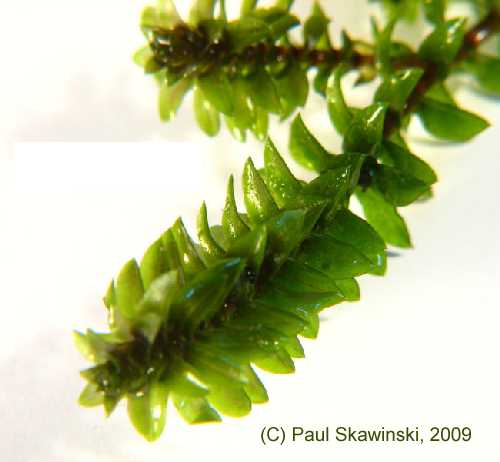
Ecological Importance
Elodea provides habitat for many small aquatic animals, which fish and wildlife eat. Geese, ducks, and swans are particularly attracted to this plant. Elodea is an excellent oxygen producer and frequently used by fish to protect fry.
Problems
Dense populations of plants reduce the water temperature and oxygen concentrations when plants die in late summer. However, dense growth of this plant can create a nuisance, and its closed, compact structure is not ideal fish habitat.
Plant Description
Elodea averages 4 inches to 3 feet in length depending on water depth. The American waterweed (Elodea Canadensis) lives entirely underwater except for a small white flower that blooms at the surface during summer. Elodea has branched stems with oval-shaped leaves arranged in clusters of three or four around the stem. The fruit of the Elodea ripens below the surface. Elodea produces heavy buds in the Fall that drop to the bottom and then begin to grow in the Spring; relying little on seed production.
American waterweed (Elodea canadensis) is what many people commonly think of as "that aquarium plant." It is also known by several other common names such as Canadian waterweed, common elodea, or anacharis. The use of these names causes it to be confused with similar-looking nonnative plants like Brazilian elodea or hydrilla.
Easily confused with Hydrilla. Helpful hints to aid in distinguishing Elodea for Hydrilla are:
- Elodea - Averages three leaves per whorl with smooth leaf edges.
- Hydrilla - Averages three to five leaves per whorl with rough toothed leaf edges.

Hints to Identify
Broad oval leaves, usually four in number, arranged in whorls around the stem. Whorls are compact near the growth tip with spacing between the whorls gradually increasing further down the stem.
Common Application Questions
Q. How much should I treat?
A. Spot treat as needed to maintain navigation channels and swimming areas. Remember this plant is very beneficial and should not be treated where it is not a nuisance.
Q. When is the best time to treat?
A. Once water temperatures are around sixty degrees or warmer however this plant responds equally well to herbicide treatment when mature.
Q. How often do I need to treat Elodea?
A. One treatment per season is usually enough.
Q. How long before I see results?
A. Generally within two weeks things will be cleared up. Maybe even sooner with Elodea
| Homeowner Treatment Options |
| Hydrothol® Granular |
| Sonar AS |
| Sonar RTU |
| *Aquatic Biologists recommends implementing preventative management techniques and physical removal prior to, or in conjunction with treatment. |
